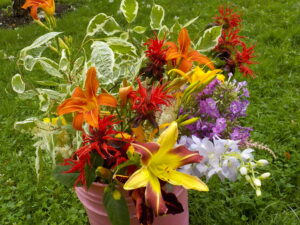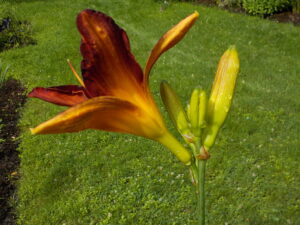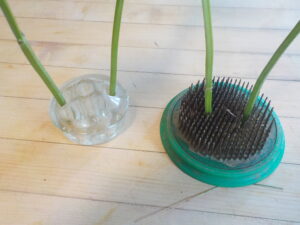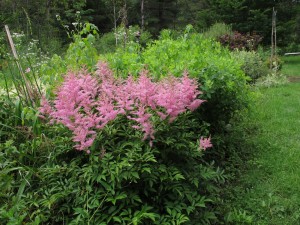Tips for picking and arranging flowers
I’ve been keeping track this year of what blooms for me, and when. So far I’ve recorded over 100 species of flowers (plus many more named varieties of the same genus) and 40 species of flowering trees and shrubs. Blooming starts with snowdrops in March and will continue on until well after frost in November with witchhazel trees blooming even after leaf drop.
Flowers with multiple blossoms on a stem (delphinium, foxglove, for example) should have some blossoms in full bloom, others showing color and some in tight bud. This will prolong the show. Flowers that grow on individual stems should be in full bloom, or just starting to open. Peonies, for example, will often have tight buds on the same stem as an open blossoms, but it is rare for them to bloom in the vase. Daylilies only bloom for a day, but a single scape can have up to 10 buds that will bloom in sequence for a week or more.
Be sure to remove all leaves or flowers that would be submersed is the vase you are using. Why? The leaves will rot and ferment; the bacteria will inhibit water uptake.
To my eye, a 6-inch vase will look good with 9-to12-inch flowers in it, but even 18-inch stems may look fine, especially of you place shorter flowers around the outside perimeter of the arrangement. I made an arrangement recently with six stems of beebalm in an 8-inch vase. I angled the stems to create support for a 24-inch stem of delphinium in the middle, standing straight up. That looked great to me.
Eight Flowers Great Flowers
“I have a brown thumb” is a claim I hear on a regular basis, but one which I always dispute. There are no brown thumbs, only bad soil or plants living (and dying) where they should not be. Of course, any plant can die of thirst when first planted, and poor soils can keep them from thriving. But some plants are tougher than others, so this week I shall suggest eight plants that you can use in your garden with a very high probability that they will do well for you. Even very well. Even if you have a brown thumb. Just put them in good soil in the right amount of sun.
Daylilies (Hemerocallis spp.) are fool proof. I once left a clump of daylilies on the lawn in a relatively shady place. I had dug them up and fully intended to put them in the compost pile, but didn’t get around it right away. Before I knew it, they had rooted in – and were blooming!
Daylilies prefer full sun and good soil, but they’re not fussy. The old orange ones spread by root, as do the double orange ones. Most others just develop into bigger clumps every year. Daylilies produce flower stalks called scapes, and each scape will produce 3 to 9 buds; these buds bloom sequentially, each for just about a day – hence the name. Most daylilies come in shades of yellow, but dark reds and some pinky ones exist, too. A few re-bloom off and on all summer.
Evening primroses or sundrops (Oenothera missouriensis) are blooming for me right now, but they are not really primroses at all. The flowers are bright yellow cups on 18 to 30-inch stems that flower – and spread – cheerfully. They spread by root and by seed, and might be thought to be thugs, except they pull easily and are pleasant. They will bloom in full sun to part shade, and are not fussy about their soil.
Peonies (Paeonia spp.) These beauties are mostly done for the season, though a few late bloomers might still be blooming. They love full sun and rich soil, but will still bloom in part shade and even in dry, sandy soils. Their roots are big, fleshy tubers that go deep down into the soil, so I recommend digging a much bigger and deeper hole for a peony than for other plants. Enrich the soil with composted cow manure, rotted leaf mulch or other organic products, especially some organic fertilizer.
Peonies grow from buds or “eyes” that develop each year beneath the soil surface. If you plant a peony too deeply and cover up the eyes with more than an inch of soil, the plant will not bloom after the first year. Other than that? Success is guaranteed. I have a peony that my grandmother Lenat planted – and she died around 1953. My mother grew it, now I have it. I shall leave it to one of my grandchildren. Peonies are forever.
Pink Mallow (Malva alcea). Some fancy gardeners turn their noses up at pink mallow, but I love it. It grows 3-5 feet tall and produces a bounty of pink blossoms that vaguely resemble single roses- but up to 3 inches in diameter. It has a deep tap root so it does not move easily, but seed-grown “volunteers” show up around my garden. Full sun to part shade. It is a short-lived perennial, but has plenty of “babies” so you will always have some.
Black-eyed Susans (Rudbekia spp.) There are dozens of species of this joyful summer flower. I grow a variety called ‘Prairie Sun’ in my hot, dry front walkway, and it blooms all summer – but, truth-be-told, often die in winter. No matter, I’ll buy it again and again. One of my favorites is a fall-season bloomer with delicate flowers, Rudbekia subtomentosa ‘Henry Eilers’.
Hostas (Hosta spp.). These are primarily shade plants grown for their lovely leaves. If there is too much sun on them, the leaves will scorch and turn yellow. A few kinds will bloom with tall flower spikes, but others have blossoms that are not of much interest. Hostas do best with rich soil, but will grow in almost any soil. I have hostas from under 2 inches tall to more than 30 inches tall, and a variety of greens, some with blue or yellow tinges.
Astillbes (Astillbe spp.). These are primarily sold as shade plants, but I grow them in both full sun and partial shade. The key is this: the more sun there is, the more moisture is needed. They bloom in great plumes of tiny florets in pink, white and dark red. They appreciate rich, organic soil, so improve the soil before planting.
Bee Balm (Monarda didyma). Bee Balm displays nice clumps of red or pinkish tubular flowers that are arranged in whorls atop 3-4 foot stems. In the mint family, they are fragrant and clumps spread by root – sometimes too vigorously. But extra plants are easily pulled. Grow them in morning sun in ordinary garden soil. All day sun in dry, sandy locations will not lead to happy plants.
You don’t have to be born a gardener. Just follow the directions on the plant tags – or my articles – and be sure to add compost to the soil before planting in a nice, big hole. You’ll soon have a green thumb.
Henry Homeyer can be reached at P.O. Box 364, Cornish Flat, NH 03746 or henry.homeyer@comcast.net. His Web site is www.Gardening-guy.com.









